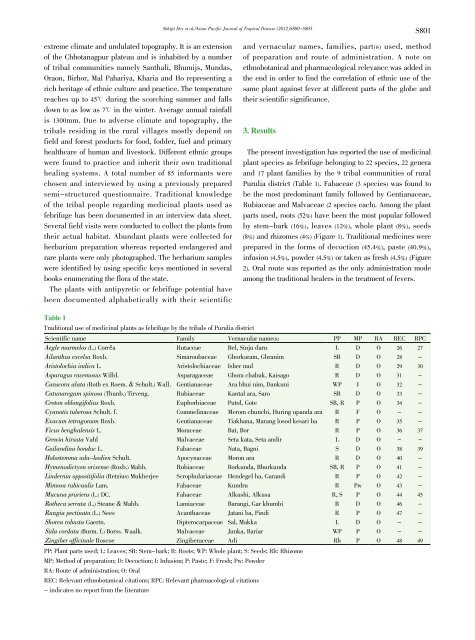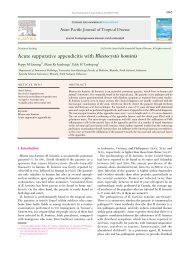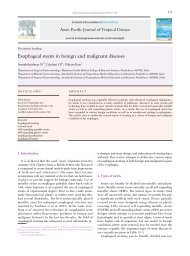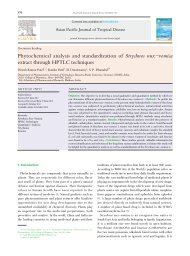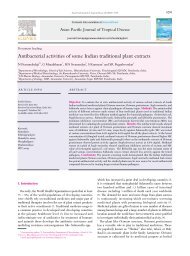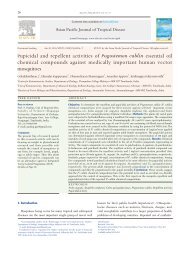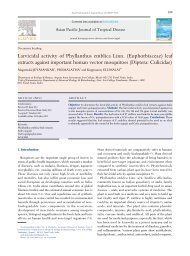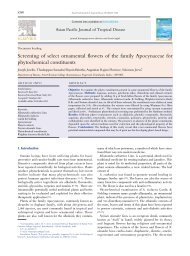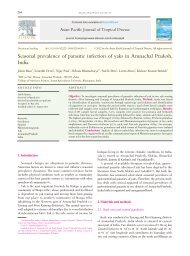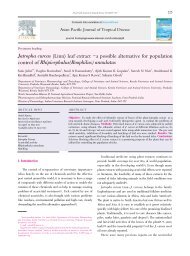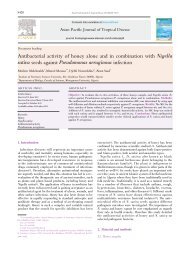Traditional use of medicinal plants as febrifuge by the ... - Apjtcm.com
Traditional use of medicinal plants as febrifuge by the ... - Apjtcm.com
Traditional use of medicinal plants as febrifuge by the ... - Apjtcm.com
You also want an ePaper? Increase the reach of your titles
YUMPU automatically turns print PDFs into web optimized ePapers that Google loves.
extreme climate and undulated topography. It is an extension<br />
<strong>of</strong> <strong>the</strong> Chhotanagpur plateau and is inhabited <strong>by</strong> a number<br />
<strong>of</strong> tribal <strong>com</strong>munities namely Santhali, Bhumijs, Mund<strong>as</strong>,<br />
Oraon, Birhor, Mal Pahariya, Kharia and Ho representing a<br />
rich heritage <strong>of</strong> ethnic culture and practice. The temperature<br />
reaches up to 45曟 during <strong>the</strong> scorching summer and falls<br />
down to <strong>as</strong> low <strong>as</strong> 7曟 in <strong>the</strong> winter. Average annual rainfall<br />
is 1300mm. Due to adverse climate and topography, <strong>the</strong><br />
tribals residing in <strong>the</strong> rural villages mostly depend on<br />
field and forest products for food, fodder, fuel and primary<br />
healthcare <strong>of</strong> human and livestock. Different ethnic groups<br />
were found to practice and inherit <strong>the</strong>ir own traditional<br />
healing systems. A total number <strong>of</strong> 85 informants were<br />
chosen and interviewed <strong>by</strong> using a previously prepared<br />
semi-structured questionnaire. <strong>Traditional</strong> knowledge<br />
<strong>of</strong> <strong>the</strong> tribal people regarding <strong>medicinal</strong> <strong>plants</strong> <strong>use</strong>d <strong>as</strong><br />
<strong>febrifuge</strong> h<strong>as</strong> been documented in an interview data sheet.<br />
Several field visits were conducted to collect <strong>the</strong> <strong>plants</strong> from<br />
<strong>the</strong>ir actual habitat. Abundant <strong>plants</strong> were collected for<br />
herbarium preparation where<strong>as</strong> reported endangered and<br />
rare <strong>plants</strong> were only photographed. The herbarium samples<br />
were identified <strong>by</strong> using specific keys mentioned in several<br />
books enumerating <strong>the</strong> flora <strong>of</strong> <strong>the</strong> state.<br />
The <strong>plants</strong> with antipyretic or <strong>febrifuge</strong> potential have<br />
been documented alphabetically with <strong>the</strong>ir scientific<br />
Table 1<br />
<strong>Traditional</strong> <strong>use</strong> <strong>of</strong> <strong>medicinal</strong> <strong>plants</strong> <strong>as</strong> <strong>febrifuge</strong> <strong>by</strong> <strong>the</strong> tribals <strong>of</strong> Purulia district<br />
Abhijit Dey et al./Asian Pacific Journal <strong>of</strong> Tropical Dise<strong>as</strong>e (2012)S800-S803 S801<br />
and vernacular names, families, part(s) <strong>use</strong>d, method<br />
<strong>of</strong> preparation and route <strong>of</strong> administration. A note on<br />
ethnobotanical and pharmacological relevance w<strong>as</strong> added in<br />
<strong>the</strong> end in order to find <strong>the</strong> correlation <strong>of</strong> ethnic <strong>use</strong> <strong>of</strong> <strong>the</strong><br />
same plant against fever at different parts <strong>of</strong> <strong>the</strong> globe and<br />
<strong>the</strong>ir scientific significance.<br />
3. Results<br />
The present investigation h<strong>as</strong> reported <strong>the</strong> <strong>use</strong> <strong>of</strong> <strong>medicinal</strong><br />
plant species <strong>as</strong> <strong>febrifuge</strong> belonging to 22 species, 22 genera<br />
and 17 plant families <strong>by</strong> <strong>the</strong> 9 tribal <strong>com</strong>munities <strong>of</strong> rural<br />
Purulia district (Table 1). Fabaceae (3 species) w<strong>as</strong> found to<br />
be <strong>the</strong> most predominant family followed <strong>by</strong> Gentianaceae,<br />
Rubiaceae and Malvaceae (2 species each). Among <strong>the</strong> plant<br />
parts <strong>use</strong>d, roots (52%) have been <strong>the</strong> most popular followed<br />
<strong>by</strong> stem-bark (16%), leaves (12%), whole plant (8%), seeds<br />
(8%) and rhizomes (4%) (Figure 1). <strong>Traditional</strong> medicines were<br />
prepared in <strong>the</strong> forms <strong>of</strong> decoction (45.4%), p<strong>as</strong>te (40.9%),<br />
infusion (4.5%), powder (4.5%) or taken <strong>as</strong> fresh (4.5%) (Figure<br />
2). Oral route w<strong>as</strong> reported <strong>as</strong> <strong>the</strong> only administration mode<br />
among <strong>the</strong> traditional healers in <strong>the</strong> treatment <strong>of</strong> fevers.<br />
Scientific name Family Vernacular name(s) PP MP RA REC RPC<br />
Aegle marmelos (L.) Corrêa Rutaceae Bel, Sinju daru L D O 26 27<br />
Ailanthus excelsa Roxb. Simaroubaceae Ghorkaram, Ghranim SB D O 28 -<br />
Aristolochia indica L. Aristolochiaceae Isher mul R D O 29 30<br />
Asparagus racemosus Willd. Asparagaceae Ghora chabuk, Kaisago R D O 31 -<br />
Canscora alata (Roth ex Roem. & Schult.) Wall. Gentianaceae Ara bhui nim, Dankuni WP I O 32 -<br />
Catunaregam spinosa (Thunb.) Tirveng. Rubiaceae Kantal ara, Saro SB D O 33 -<br />
Croton oblongifolius Roxb. Euphorbiaceae Putol, Gote SB, R P O 34 -<br />
Cyanotis tuberosa Schult. f. Commelinaceae Merom chunchi, Huring upanda ara R F O - -<br />
Exacum tetragonum Roxb. Gentianaceae Tiakhana, Marang losod kesari ba R P O 35 -<br />
Ficus benghalensis L. Moraceae Bat, Bor R P O 36 37<br />
Grewia hirsuta Vahl Malvaceae Seta kata, Seta andir L D O - -<br />
Guilandina bonduc L. Fabaceae Nata, Bagni S D O 38 39<br />
Holostemma ada-kodien Schult. Apocynaceae Moron ara R D O 40 -<br />
Hymenodictyon orixense (Roxb.) Mabb. Rubiaceae Borkunda, Bhurkunda SB, R P O 41 -<br />
Lindernia oppositifolia (Retzius) Mukherjee Scrophulariaceae Hendegel ba, Garandi R P O 42 -<br />
Mimosa rubicaulis Lam. Fabaceae Kundru R Pw O 43 -<br />
Mucuna pruriens (L.) DC. Fabaceae Alkushi, Alkusa R, S P O 44 45<br />
Ro<strong>the</strong>ca serrata (L.) Steane & Mabb. Lamiaceae Barangi, Gar khumbi R D O 46 -<br />
Rungia pectinata (L.) Nees Acanthaceae Jatani ba, Pindi R P O 47 -<br />
Shorea robusta Gaertn. Dipterocarpaceae Sal, Makka L D O - -<br />
Sida cordata (Burm. f.) Borss. Waalk. Malvaceae Junka, Bariar WP P O - -<br />
Zingiber <strong>of</strong>ficinale Roscoe Zingiberaceae Adi Rh P O 48 49<br />
PP: Plant parts <strong>use</strong>d; L: Leaves; SB: Stem-bark; R: Roots; WP: Whole plant; S: Seeds; Rh: Rhizome<br />
MP: Method <strong>of</strong> preparation; D: Decoction; I: Infusion; P: P<strong>as</strong>te; F: Fresh; Pw: Powder<br />
RA: Route <strong>of</strong> administration; O: Oral<br />
REC: Relevant ethnobotanical citations; RPC: Relevant pharmacological citations<br />
- indicates no report from <strong>the</strong> literature


